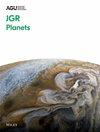Geostratigraphic Mapping of the Intrusive Valentine Domes on the Moon
Abstract
Lunar intrusive igneous domes have not been the center of much research in the past due to their rare occurrence on the lunar surface, and the difficulty in locating them. Most of the known structures were discovered using images with low illumination angles, including data from the Lunar Orbiter, telescopic images, and photos taken during the Apollo Missions. These intrusive domes are characterized by an oval shape and low slopes. We analyzed one of these systems, the Valentine domes, located near the rim of the western Serenitatis basin, with modern techniques and data sets from the Lunar Reconnaissance Orbiter (LRO) and Chandrayaan-1 missions. We created a geostratigraphic map of the area, combining geomorphological and spectral classifications. The aspect map (direction of the slope) proved to be the most suitable product to locate and delimit these structures; using it, we identified a new dome southeast of the principal body, suggesting that the intrusive system is larger than previously thought. It was found that the three domes can be classified as laccoliths, and that several derived structures such as rilles, dykes, and secondary domes represent different stages of intrusive activity in the area. Based on crater counting analysis, we determined that the intrusive activity began after 2.98 ± 0.15 Ga and lasted at least until 1.88 ± 0.5 Ga ago.


 求助内容:
求助内容: 应助结果提醒方式:
应助结果提醒方式:


